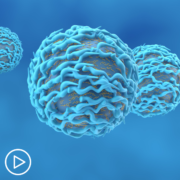How Does Immunotherapy Treat Myeloma?
How Does Immunotherapy Treat Myeloma? from Patient Empowerment Network on Vimeo.
Immunotherapy harnesses one’s own immune system to fight cancer. Dr. Krina Patel, a myeloma specialist and researcher, explains how this therapy changing the treatment landscape for myeloma.
Dr. Krina Patel is an Associate Professor in the Department of Lymphoma/Myeloma at The University of Texas MD Anderson Cancer Center in Houston, Texas. Dr. Patel is involved in research and cares for patients with multiple myeloma. Learn more about Dr. Patel, here.
Related Resources:

|

|

|
Transcript:
Katherine:
We’ve been hearing a lot recently about immunotherapy. Would you tell us what it is and how it works to treat myeloma?
Dr. Patel:
Yeah, so I think immunotherapy is sort of where everything is really changing the way we look at myeloma. So, I’ll date myself a little bit, but 15 years ago when I was a first-year fellow most people thought that immunotherapy wouldn’t necessarily work for myeloma. So, in all cancer care we have surgery possibly in myeloma.
We don’t use it as much, but if someone has a bone lesion that we need to do we might do some surgery there. We use radiation sometimes if we really need, for painful lesions or something that might be at risk for fracture. And we use chemotherapy all the time for treatment.
Immunotherapy is actually different types of medications. Some are proteins. Some are biologics that we can talk about it. But really, they harness your immune cells, all the other white blood cells that are in your bone marrow and in your blood, to actually go after the myeloma themselves. And so, there’s different ways we can do that. And, again, 15 years ago most people said, “No, we’re not going to be able to use immune therapy for myeloma because plasma cells,” which are myeloma cells, “are a white blood cell. So, their sisters, brothers, cousins, whatever you want to call those other white blood cells, how do we turn those into the enemy, or how do we make myeloma the enemy?”
And so, it took a long time for us to figure it out, but really, it’s about using your immune cells to kill that myeloma.



